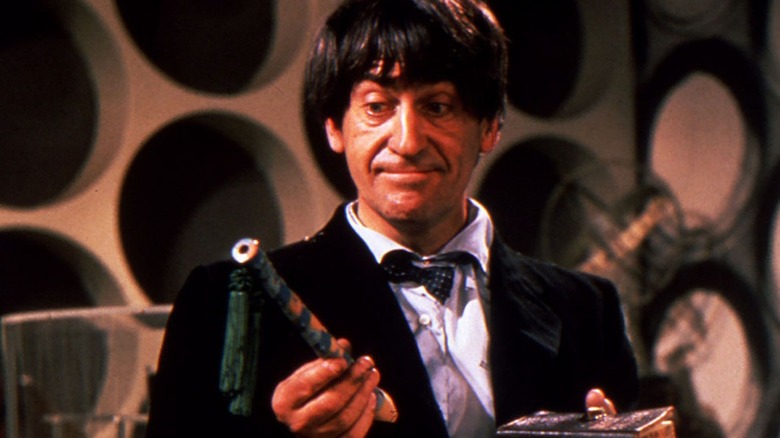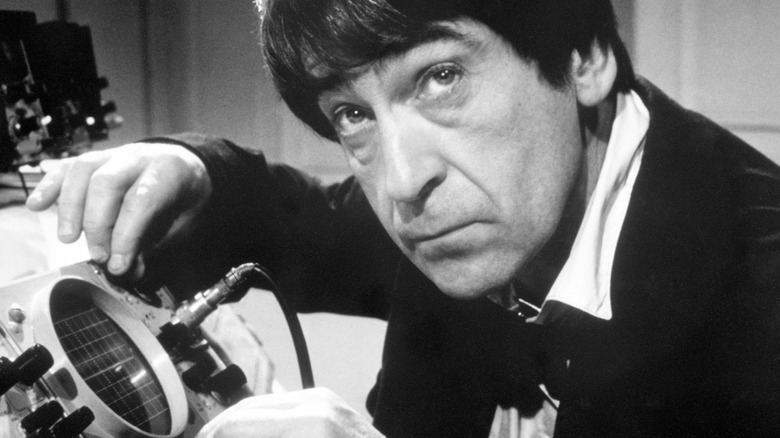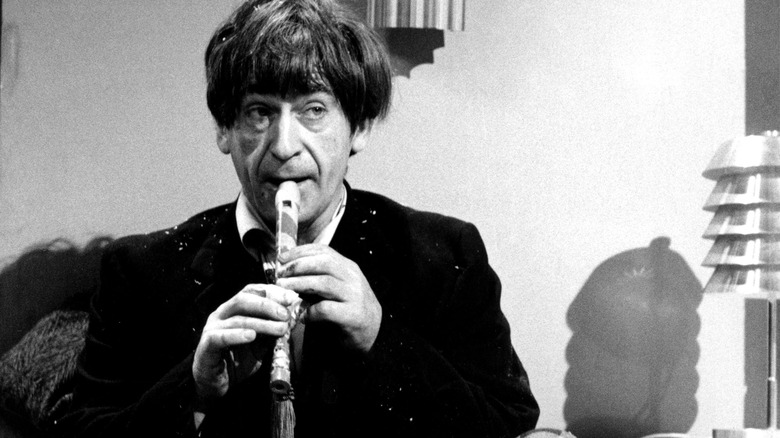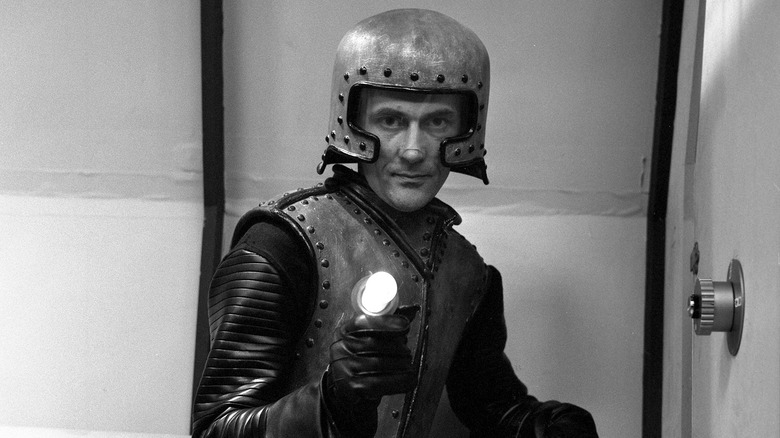These Patrick Troughton Doctor Who Episodes Were Missing For Decades
The early days of "Doctor Who" were the Wild West. The low-budget sci-fi show, which debuted in 1963 with William Hartnell as the title character, was a fast-and-dirty content mill with lightning-quick turnaround times and a production schedule like a diner during Sunday brunch. Individual BBC staff writers, working variously on multiple projects, would be assigned separate "Doctor Who" stories, and scripts had to be turned over as hastily as possible. Over the first several years of the show's broadcast, it was a factory. The show's interiors were shot on video in the BBC studios, and the exteriors shot on 16mm film. Unusually — and perhaps this was because they wanted the show to look as awful as possible — the video and film elements would be edited together, and then the complete episode would be filmed again from a video monitor before being sent out to broadcast. The reason for the double-filming is a mystery to film archivists and broadcasters everywhere.
Continuity generally wasn't paid very close attention to in these early days, as the production model (separate staff writers working independently of each other) prevented any kind of consensus about "Doctor Who" from forming, and using a series bible was not yet common practice. It wouldn't be until sometime in the 1980s — after a generation had passed and the people who watched "Doctor Who" as children took over the show to give it a more solid basis — that continuity would become more of a palpable concern.
In the modern era (that is, post 2005), "Doctor Who" was presented in an episodic monster-of-the-week structure. At the end of every episode, the drama would conclude with continuity and larger story arcs occupying the background. In contrast, the early days of "Doctor Who" saw the series running in three or four episode cycles, each written by a different author. Sometimes the cycles would continue in arcs of seven chapters, sometimes fewer, but it was, in modern parlance, a miniseries-based show. Because "Doctor Who" was made on such a breakneck schedule, the arcs would eventually begin to continue indefinitely, with each successive episode being written on the fly and denouements delayed until an idea struck.
The episodes would then be dubbed onto cassettes, with many shipped out all over the globe for broadcast in British territories, and a few kept in the BBC vault where no one would touch them for years.
The lost episodes
For many years, old "Doctor Who" videocassettes were stored in an archive to collect dust. This was the 1960s, and there was no thought given to a future home video market — Blockbuster Video was but a glimmer in David Cook's eye — and the show's original film elements were left to rot. After the "Doctor Who" videocassettes had been sitting around for about a decade, the BBC, needing new cassettes to film on, would simply tape over them, effectively erasing any sort of archive they had amassed. The BBC's cavalier attitudes toward their storage process makes modern audiences and film archivists wince, but this was standard practice in the day. Reusing film elements, cassettes, and other supplies was done for reasons of economy, and the producers of shows and films didn't imagine that audiences would necessarily want to have access to their work decades later. So when you learn that "Doctor Who" episodes had been taped over, or that the original animation cels for "Snow White and the Seven Dwarfs" had been washed off and used on other productions, understand that it wasn't done to spite audiences of the future.
These days, there is a lot more careful attention paid to film archiving, and most major studio films — even if shot and projected digitally — have 35mm prints struck so they can be stored in a vault, a library, or a salt mine in Kansas (salt mines are particularly good for storing film, as they are always cool and dry).
On "Doctor Who," actor Patrick Troughton played the second Doctor — the character is a space alien who can die and "regenerate" into the body of a new actor, a practice that has been done over a dozen times in the show's history — whose tenure spanned the fourth, fifth, and sixth seasons of the show in 1966 to 1968. Each Doctor has a personality gimmick or a habit unique to them, and Troughton's Doctor was that he played the recorder.
The show is currently gearing up for its 40th season, having taken a hiatus from 1989 to 2005 (with an ill-fated American TV movie in the middle). Most of those episodes were taped over, and for many years, they were considered lost.
Fables of the reconstruction
When a studio doesn't care to store their own shows, a pirate becomes an archivist. Thanks to some enterprising fans, many of the lost episodes of "Doctor Who" have been restored over the years. Because the BBC cassettes were shipped all over the world for broadcast in international markets, the were not beholden to the great BBC cassette re-usage wave of the late 1970s. Many fans began calling TV stations in Cyprus, in Ethiopia, in Nigeria, anywhere there was a record of "Doctor Who" on the TV schedule.
After a lengthy hunting process of calling, hunting, and digging through videocassette archive rooms, episodes did begin to reappear. The BBC wrote a letter to a long-ago affiliate in Australia, and 13 lost episodes of "Doctor Who" were returned. In 2013, two entire Patrick Troughton serials were recovered in Nigeria: "The Enemy of the World" and "The Web of Fear." The serial entitled "The Wheel in Space" was also recovered in its entirety from Cyprus, but the sound elements had been damaged. Luckily for archivists, certain fans were so obsessed with the show that they, just for their own edification, recorded the audio from the episodes straight from their TV sets into home audiocassettes. It was a mere editing process to remarry the recovered video and fans' audio. Know, reader, that those weird audio or video projects you're working on may be preserving your object of affection in ways you cannot predict.
A fan name Craig Cabell allegedly also — using a web of broadcasting records and shipping — tracked down several lost Patrick Troughton episodes to TV stations in what some believe might be Syria or Yemen. Cabell was coy about the actual country of origin, sharing on online fans groups only that they were located in "war zones." These claims, while based on actual shipping manifests and the like, should be taken with a grain of salt. As "Doctor Who" fans have sought to find all the missing Troughton episodes, a cottage industry of false leads and rumors has also been created. It will be difficult to say what is actually found until it is actually recovered and screened.
Where they were found
The story of "Doctor Who's" archival process has become so labyrinthine and difficult that Whovians have formed restoration and recovery teams to gather up all the show's missing footage. Because the videos have come from such diverse places, there are online records as to where they were picked up.
As of this writing, 97 episodes of "Doctor Who" remain lost.
If any readers have access to TV archives in Yemen, they would do well to ask if there are any old "Doctor Who" episodes hiding within. If you know someone at the BBC, or even a star of "Doctor Who," have them remain on alert should their shows be scheduled for demolition; something similar happened when a fan at the BBC alerted "Monty Python's Flying Circus" star Terry Jones to the upcoming cassette purge. Jones, after receiving the call, swooped in a saved all the "Flying Circus" cassettes personally. Perhaps an enterprising editor, fan, archivist, or someone looking in the basement of a rec center in Lesotho will turn something up. They're all likely out there somewhere.
Special thanks to Kyle Anderson for important background information featured in this article.



